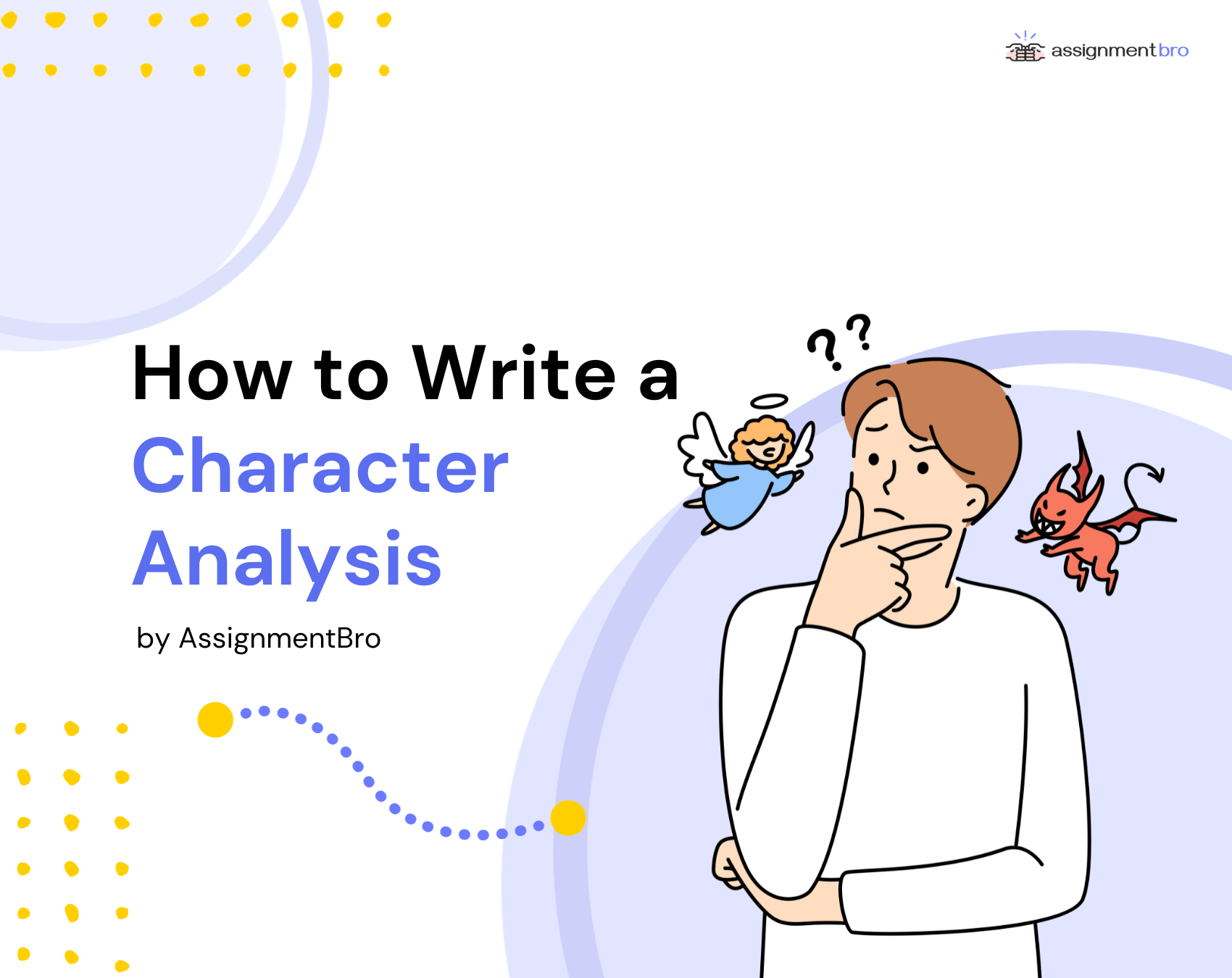Learn How to Write a Character Analysis Assignment Correctly
Table of Contents
- What Is Character Analysis in Writing?
- The Importance of Character Analysis
- Character Types in Literature:
- Additional Categories:
- Crucial Elements of Character Analysis
- Step-by-Step Guide to Writing a Character Analysis
- Popular Writing Pitfalls and Ways to Avoid Them
- ✅ Do’s:
- ❌ Don’ts:
- Character Analysis Example
- The Use of Strategic Thinking

When you are asked to write character analysis assignment, the most important thing is to understand what type of analysis is required and who your target audience is. If you plan to write a character analysis paper for high school, it will be different from a more complex assignment for college students. A character analysis involves analytical work, as the name implies, focusing on specific qualities and traits related to a chosen person. While the talk can easily revolve around characters in literary works or poetry, one can also turn to cinema and television for inspiration.
What Is Character Analysis in Writing?
A character analysis is a piece of academic writing that aims to provide a clear and accessible evaluation of the fictional or real-life person, depending on the context.
The main purpose is to determine the nature of the character by trying to determine whether we are dealing with a static or a dynamic type of person. It is also where the writer must identify the character’s role in a chosen story or movie. The complex part here is that your target audience must see an introduction of the character and the logic behind your writing. Therefore, one must focus on the relationships, certain actions, wrongdoing, positive traits, comparisons, and practical examples that can help you see your point. If you having troubles with character analysis writing ask help from our assignment writers.
Depending on your take on things and the complexity of given objectives, it is possible to implement at least five different methods to start your character analysis assignment. These may include but are not limited to the following:
- A physical description.
- Analysis of actions taken.
- Inner thoughts and reflections.
- Speech figures.
- Reactions that define a character.
Essentially, a good character analysis essay always comes down to how well the characters are developed and what methods have been used by the original authors to develop the message and characteristics of each individual. If a positive and clear image is created for the audience, it is much easier for students and readers to analyze the character.
Your assignment can be completed in 3 hours!
Has your deadline come quicker than you expected? No worries! We have what you need – a 3-hours deadline option! All features available for any other order applied, including:
- 100% original assignment
- Free formatting and reference list
- 24/7 online support
The Importance of Character Analysis
Character analysis is one of the best ways for students and teachers to analyze given material and approach literary works through the lens of evaluation. As we may remember our first children’s books, we may easily outline the good and the bad characters often depicted as animals, superheroes, or villains. As we grow older, using character analysis assignments helps us take notes and analyze what we have learned. It also helps to understand and explain what an original author has meant in their writing. In certain cases, you may be asked to determine the type of the character, compose a thesis statement for character analysis, and make an assumption as to how this character would act in different circumstances or when taken to the present times.
An excellent character analysis paper should not be made static as one of the creative tasks, as flexibility and creative thinking are the keys to success. The key is not to sum up things and summarize what you know about the character but to try and evaluate why something has been done, or certain words have been spoken. Such an approach will help narrow things down and improve your analytical skills as you make your writing more accessible, clear, and inspiring for others.
Character Types in Literature:
- Protagonist: Central character, usually undergoes change or growth.
- Antagonist: Opposes the protagonist, creates conflict.
- Sidekick: Supports and highlights the protagonist, often provides comic relief.
- Mentor: Experienced guide for the protagonist, aids in their development.
- Minor Characters: Further the plot but aren’t central, part of subplots or atmosphere.
- Foil: Contrasts with another character to highlight specific traits.
Additional Categories:
- Static: Remains unchanged throughout the story.
- Dynamic: Undergoes significant internal change.
- Flat: Simple, two-dimensional, unchanged.
- Round: Complex and undergoes development.
Understanding these types can enrich your character analysis by helping you categorize roles, motivations, and developments. It means that your character analysis assignment should be supported with good examples and citations to provide proof of good character analysis writing.
Crucial Elements of Character Analysis
Although there are numerous ways to create a characterization assignment, the most important is to focus on the vital elements that make your analytical work relevant. The most common character types elements include a physical description, the use of dialogues, actions taken, thoughts expressed, and the character’s role in the story. Let’s focus on each aspect in greater detail:
- A Physical Description. This element stands for a character’s physical or facial features, including appearance, the character’s age, and specific elements like a beard, long hair, wearing old-time dresses, or being a buccaneer with a wooden leg!
- The Dialogues. Analyzing character via a dialogue, quite a lot can be determined if we look at the dialogue. If the person is soft-spoken, strict, rude, always angry, or silent most of the time. Think about what it says about the character and what may be the causes for that.
- Actions. It often comes to the moral side of things as we determine whether some character is honest or insincere, good or bad, helpful or ignorant.
- Thoughts. These self-dialogues and the thoughts expressed by the author help to outline character traits. Use these as examples to assist you as the evidence through your writing.
- Role in The Story. It is one of the most important aspects to consider as we can have a protagonist, antagonist, tertiary characters, romantic interests, confidants, foils, and other characters. If unsure, consult your academic advisor or check with the various book reviews to determine your specific character type.
Step-by-Step Guide to Writing a Character Analysis
Writing a character analysis assignment might sound frightening but do not let it frighten you. Here are the steps on how to write an assignment about a character that you must follow to achieve success and submit your work on time:
- Step 1: Choose your character and collect notes about what makes them stand out based on what you already know.
- Step 2: Read the story with a single focus on that character alone. It should be similar to writing an article review to outline a single problem. Now, you must determine your character’s traits separately!
- Step 3: Create a background about the character that explains the settings.
- Step 4: Create a thesis that represents the main idea of the character (identify the character type).
- Step 5: Create an outline of the actions and thoughts expressed through the story’s timeline or a film.
- Step 6: Provide an attention-grabbing hook in the beginning to inspire your audience.
- Step 7: Use topic sentences in the body paragraphs with explanations and examples.
- Step 8: Provide a strong conclusion where you talk about the character’s role and importance for the story and you as a writer.
Popular Writing Pitfalls and Ways to Avoid Them
When working on your character analysis, you should avoid certain mistakes or mention that the original author has made them. It will require a bit of analysis and evaluation. For example, if the main character is introduced too late, it is one of the worst pitfalls in literature. Now, a character analysis must avoid the same mistake by providing the character’s name, age, and other vital background data to help put things in perspective. Some other mistakes to avoid include the following:
- Avoid a one-dimensional analysis where you focus on the good or the bad, i.e., only character traits regardless of a person’s role in a book.
- Avoid missing examples that should support your arguments.
- Do not provide character trait essay statements that cannot be supported with evidence.
- If it is your conclusion or thoughts, always mention it and state that you believe so.
- Avoid missing experiences and events that have changed people from good to bad and vice versa.
- Do not use the first person in a character analysis assignment unless asked.
✅ Do’s: |
❌ Don’ts: |
|
|
Character Analysis Example
Undoubtedly, it is best to learn by checking several character analysis samples based on a specific book or a popular film. The most important is to notice how the character development takes place, especially if you know the book well. Start with a book you like, focus on a character you can easily evaluate, and take notes before diving into an actual character analysis example.
For example, if you are talking about the character called Simon from “Lord of the Flies” by William Goulding, you may combine your thoughts and the actual quotes:
“Simon is the voice of sanity in the book as his character speaks of self-fear and focuses on reflection and empathy. ‘There is nothing in it, of course. Just a feeling. But you can feel as if you’re not hunting, but – being hunted, as if something’s behind you all the time in the jungle.’ (p 53) part helps to explain how Simon sees danger as something tactile, which shows him as an analyst and a guide through emotions”.
The Use of Strategic Thinking
Summing things up, it is essential to understand the author’s agenda and inner work before starting with a character analysis. It means you have to think just like a writer and use strategic thinking to determine each important aspect. While you can easily read a novel or watch a film, you should go beyond the image that builds in your head because many emotional factors and typical character traits must be included. It must be brought together even if you talk about statistics, demographic groups, speech figures, or country-specific elements. Once this aspect is achieved, it makes a major difference and makes it much easier to complete an excellent character analysis assignment.
If something still remains unclear, you can ask an academic advisor, read the book or watch a film again, or seek academic writing help by asking trained experts. As a team of specialists, we are ready to assist you with your writing and editing challenges 24/7. Feel free to ask, and we shall help you achieve success!


 Log In
Log In
